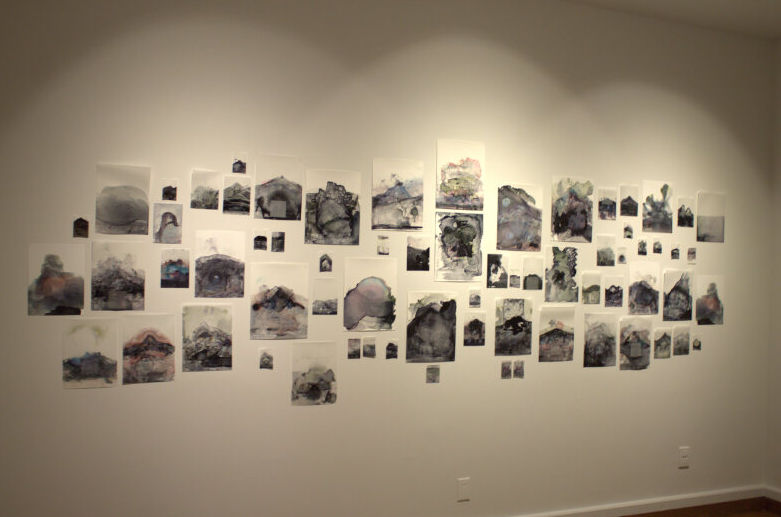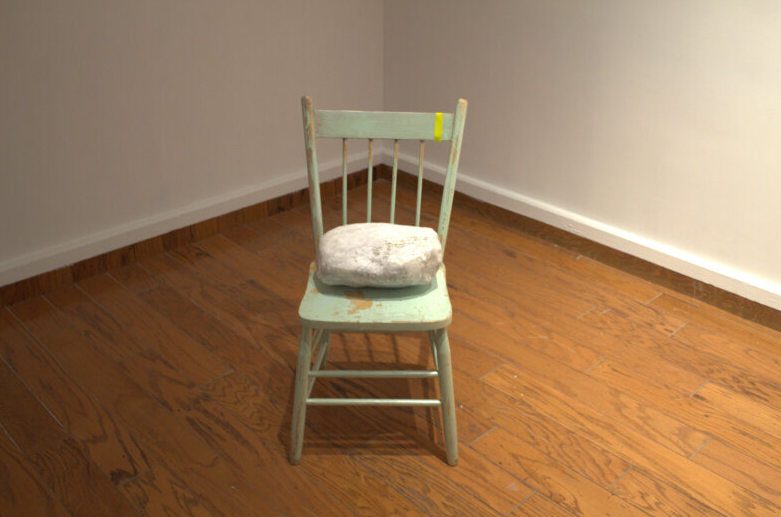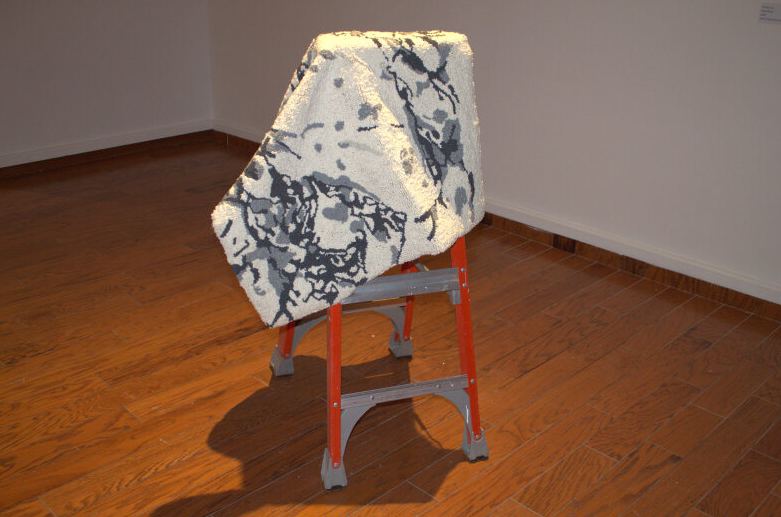
A Love so deep it’s etched in stone
curated by Logan macdonald
July 9 - September 29, 2024
Reception: friday, September 13, 5-7pm
Join curator Logan MacDonald and artists Megan Samms, Billy Gauthier, and Marc Losier for a talk as part of the A Love So Deep It’s Etched in Stone group exhibition.
A reception will follow.
A group exhibition curated by Logan MacDonald, centred around extraction and harvesting from the land.
Featured Artists
Logan macdonald: a letter from the curator
Hi Mom,
How are you? I hope you’re well.
I am writing you this letter to tell you about the group art exhibition I curated called “a love so deep it’s etched in stone”, currently on display at the Grenfell Art Gallery. I think you will really enjoy all the artworks, especially after I explain the impetus and the central themes that thread the show together.
The invitation to curate an exhibition at the Grenfell Art Gallery was given with few limitations, but right from the start I knew that I wanted to present a group show that would include artworks that (in some way) would speak to the region of Western Newfoundland, to establish a conversation with the landscape where the works were being shown. Prior to my invitation to curate this project, as you’ll remember, I’d recently visited Italy, where I was awestruck by the endless quantity and quality of centuries-old figurative marble sculptures. Every time I’d encounter a marble statue, I’d fantasize about visiting the Carrara marble quarry where all this marble was likely mined from. I’d dream about obtaining a piece of stone and taking a class to learn how to carve marble like an Italian master sculptor. I’m still completely amazed by the craftsmanship, details, realism, and scale of many of those ancient pieces. In seeing so much marble in one place, I became fascinated with how this resource has been extracted, which also made me wonder about our own access to these types of mineral resources back home. I started thinking about the geology of Western Newfoundland; and I have been curious ever since about the marble at Marble Mountain, along the Tablelands, and throughout the Long Range Mountains. Might these be potential sites to support the harvesting of organic matter and minerals for artistic creation? Have artists or ancestors accessed them before? I have been curious what marble from our region looks like. Is it accessible? Is it pliable? And can we—or more importantly and critically, should we use these resources in the comparable ways that other parts of the world have (culturally and industrially)? As someone with Indigenous ancestry connected to this land, I am cognizant about being responsible as I think about harvesting resources from our landscapes: what is and isn’t acceptable? These questions have been swirling around in my head, and thus became the thematic bedrock for this group exhibition: asking artists to provide works that connect to these ideas, which may also highlight their relationships and responsibilities to the land, resources, community, and their own creativity.
Through initial conversations with artists, I realized that I was not alone in my questions and concerns regarding how we as artists (and more broadly: people) access materials and feel a responsibility to our landscapes and cultural communities. At the forefront of conversations I had with artists, was an acknowledgment of the more macro issues concerned with our complicit participation of extraction from the land through consumerism—and how these systems continues to harm our environments and communities. Most (if not all) the artists I spoke with, who are in this exhibition, were aligned in thinking about the ethics of their artistic methodologies in accessing resources. Many where quick to make ethical distinctions around their conscious efforts to forage materials, as opposed to supporting industrial extraction and commercialization of resources they could themselves find and harvest. For instance, Billy Gauthier, Megan Samms, Jerry Ropson, and Jordan MacDonald each incorporated materials they directly harvested from the land themselves. The works by Marc Losier, Hazel Meyer and Alysha Seriani extended on these conversations to address concerns of connection, access, and memorialization of community and place.
Billy Gauthier’s featured sculpture is a composite of organic material and natural minerals he independently found within his native Labrador landscape. Like all his sculptures, he carved and manipulated these materials into figurative tableaux that speak to Inuit traditions, storytelling, and present-day issues of his land and community (as he eloquently speaks about in the accompanying video work that is also featured in this exhibition).
Likewise, Megan Samms’ series of plein air water-colour drawings not only offer landscape representation of the Long Range Mountains, but the work is materially linked to the landscape, with how Samms gathered and prepared pigments and incorporated minerals from the geographical areas depicted in her landscape portraits. Samms’ cultivates a dedicated creative practice working with materials and minerals harvested from the landscapes she lives in (mainly Katalisk/Codroy Valley) to create site-specific dyes and pigments, which is her own Indigenous (Mi’kmaq and Nlaka’pamux) and artistic intervention against commercialization of landscapes. Focusing on creating her own artistic materials also serves as a means for her to deepen knowledge and sustain a connected relationship to her surrounding ancestral homelands.
Jerry Ropson’s immersive installation showcases an industrious set of intimate eerie mountain-like drawings that amass together to present a larger rolling landscape mural. Each of the smaller drawings were developed through intensive studio experimentation by incorporating mixtures of inks and minerals harvested from various mountain landscapes. Displayed alongside his drawings, Ropson also showcases a row of tiny, extracted rocks and pebbles, which present an intimate viewing experience of collected stones that sits at the summit of his mammoth mountain portrait. Ropson’s installation provides both visual and material references that connect us to geographies, and additionally his work builds symbolic meaning around displacement, migration, ownership, and memories that connect or disconnect us to landscapes.
Marc Losier’s large-scale diptych photo-installation feature a series of cascading overlaid duotone-blue archival photographs, which depict a landscape montage of translucent, uninhabited mountains of West coast Newfoundland that atmospherically fade into the distance. Losier’s installation presents a repetition of images, which draw attention to the vastness of the landscape, while simultaneously offering a curated view of these landscapes as untouched. The work is both archive and fantasy; specifically, the images Losier’s incorporated were sourced from regional archival collections, while his intentional re-framing of the images is an intervention in our present understanding of this landscape, allowing viewers to insert themselves into the image to revisit, re-imagine, and fantasize about the magnificent vistas of the landscape, as they once existed untouched in the past.
The sculptural installation by Hazel Meyer, and accompanying video by Meyer and Alysha Seriani make direct and critical reference to marble as an artistic material capable of nuanced conversations about value, labour, and inheritance. Both works connect to Meyer’s iterative project “The Weight of Inheritance” (2019-2024), which centres around Meyer being gifted what was described as a “tonne of the late Canadian artist and experimental filmmaker Joyce Wieland’s marble.” While this gift never actualized, Wieland’s elusive marble has been the anchor for which Meyer’s project is tethered to, in fantasizing about the aftermath of such a gift. For this exhibition, I was drawn to Meyer’s focus on cultural and historical weight: how this gift of marble was equally weighted both physically and emotionally. These ideas become articulated throughout Meyer and Seriani’s work with how marble is hypothesized through the performance of moving slabs of marble featured in the video, alongside the weightless soft sculpture Trompe-lœil marble rug sculpture, which provides relief from the actual weight. Additionally, these works critically speak to marble as an artistic material that holds a historical burden: addressing the problematic divides between craft and art as separate (low and high) class forms of expression, the accessible challenges of artistically labouring with this material, and the disparate cultural vocabularies that are associated with marble.
Work by Jordan MacDonald (you know him!) is also included in this exhibition. I have been really excited by the ideas he has been working through creatively, which resonates in this exhibition. In response to discussions about our landscape as a potential site for resource extraction, MacDonald decided to present a work that would capture restraint and limitation. This is why the surface of the marble has been carved and left rough. The work is a symbolic act of resistance against industrializing of (not only) resources, but of people and communities as well – which is why the stone has been personified, seated on a re-purposed (vintage Newfoundland) chair. MacDonald suggests that we use only what is needed, within our means, and aim to protect what we have – taking cues from our Mi’kmaq ancestors, who have done this for time immemorial. His work is call and a fearful warning against industrial extraction.
Ultimately, the premise of this critical exhibition expanded, formed, and calcified through significant conversations with artists, as we discussed nascent concerns related to our practices and the places we are connected to, and aim to preserve. Thankfully, it was surprisingly effortless to find relative works which could be brought together to hold these conversations within this exhibition. While there are still linger questions with respect to how we as artists and consumers independently move forward – it’s safe to say that we are all actively thinking about what it means to honour, respect, and protect the places and communities we belong to. I think above all, the reason you will appreciate this exhibition, is because it speaks to what makes our homeland so distinct: it’s been a landscape that has been cared for and considered. What can I say, this show reveals a love so deep it’s etched in stone.
Love you,
Logan







